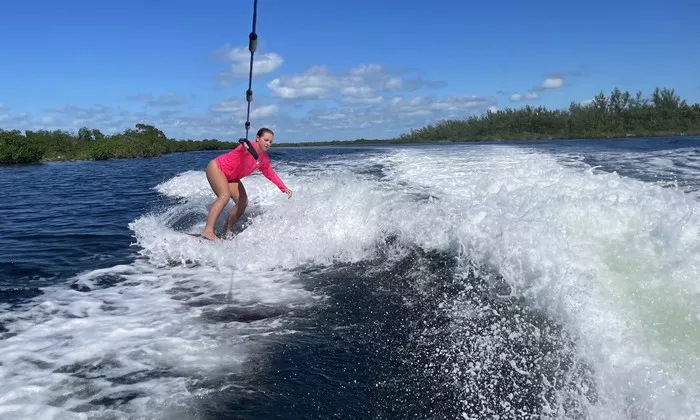Slalom water skiing is a thrilling watersport that combines elements of balance, agility, and speed. Originating in the early 20th century, slalom skiing has evolved into a popular recreational and competitive activity enjoyed by enthusiasts worldwide. The essence of slalom skiing lies in navigating a series of buoys placed in a straight line while being towed behind a motorboat.
Benefits of Slalom Water Skiing:
The allure of slalom skiing is multifaceted, appealing to individuals seeking excitement, fitness, and the joys of outdoor recreation. The sport offers a unique blend of adrenaline-pumping action and serene waterside vistas, making it a favorite pastime for many. From improving balance and coordination to providing a full-body workout, slalom skiing presents a host of physical and mental benefits for participants of all ages.
Essential Equipment:
Before venturing onto the water, it’s essential to gather the necessary equipment to ensure a safe and enjoyable experience. The primary gear for slalom skiing includes:
- Skis: Specialized slalom skis designed for agility and speed.
- Bindings: Secure bindings that keep the skier firmly attached to the skis.
- Life Jacket: A Coast Guard-approved life jacket for buoyancy and safety.
- Wetsuit (Optional): Provides insulation and protection from cold water.
- Tow Rope: A sturdy tow rope with a handle for the boat to pull the skier.
Getting Started:
1. Finding a Suitable Location:
Choosing the right location is crucial for a successful slalom skiing session. Look for a body of water with minimal boat traffic and calm, smooth conditions. Lakes, reservoirs, and designated ski areas are ideal choices for beginners, offering ample space and safety.
2. Safety Precautions:
Safety should always be the top priority when engaging in watersports. Before hitting the water, ensure that all participants wear properly fitted life jackets. Additionally, designate a spotter on the boat to keep an eye on the skier and communicate with the driver. Familiarize yourself with hand signals for communication, including signals for speed adjustments and stopping.
3. Pre-water Instruction:
Before taking to the water, it’s essential to receive instruction on basic techniques and safety protocols. Learn the correct body positioning for a successful deep water start, including how to hold the tow rope and position your skis. Practice communicating with the boat driver using hand signals for speed adjustments and direction changes.
Basic Techniques:
1. Deep Water Starts:
Mastering the deep water start is the first step towards becoming proficient in slalom skiing. Begin by floating on your back with the skis parallel to each other and the tow rope between them. As the boat starts to pull, gradually shift your weight forward while keeping your arms straight. Maintain a slight bend in your knees and allow the boat’s momentum to lift you out of the water.
2. Body Position:
Achieving the correct body position is essential for maintaining balance and control while skiing. Keep your knees slightly bent and your weight centered over the skis. Lean forward from the hips with your arms extended, maintaining a relaxed but engaged posture. Avoid leaning too far back or forward, as this can disrupt your balance and stability.
3. Edge Control:
Understanding how to control your edges is fundamental to navigating the waters with precision. To turn left, apply pressure to your right edge, and vice versa for turning right. Experiment with shifting your weight and edging techniques to maintain control and adjust your trajectory as needed.
4. Turning:
Turning is a fundamental skill in slalom skiing, allowing you to navigate around buoys and obstacles with ease. Start by practicing wide, sweeping turns to get a feel for the movement and balance required. As you gain confidence, gradually increase the speed and intensity of your turns, aiming to carve smooth arcs through the water.
Progression and Practice:
1. Building Confidence:
Like any skill, mastering slalom skiing requires patience, practice, and perseverance. Don’t be discouraged by initial challenges or setbacks; instead, view them as opportunities for growth and improvement. Start by focusing on mastering the basics before gradually advancing to more complex techniques.
2. Developing Skills:
As you gain confidence and proficiency in slalom skiing, consider exploring more advanced techniques and maneuvers. Experiment with crossing the wake to challenge your balance and agility, or practice carving turns to refine your control and precision. Set achievable goals for yourself and celebrate your progress along the way.
Conclusion
In conclusion, slalom water skiing offers an exhilarating blend of excitement, athleticism, and outdoor adventure. By following the principles outlined in this guide and committing to regular practice, beginners can embark on a rewarding journey towards mastering the waves and experiencing the thrill of slalom skiing firsthand. So grab your skis, hit the water, and prepare to make a splash in the world of watersports!

